Effect of mouthrinses on surface roughness and of a nanofilled restorative composite
DOI:
https://doi.org/10.14295/bds.2014.v17i3.1014Abstract
Objective: The aim of this study was to evaluate the effect of mouthrinses on the surface roughness of the nanofilled restorative composite. Material and Methods: Twenty discs (4 mm in diameter and 1 mm in height) of the composite Filtek Z350 were made and roughness (µm) was measured using perfilometer with a 0.5 ?m diamond needle tip measuring and accuracy of 0.01 ?m. The discs were randomly divided into four groups (n=5): Control (distilled water), G1-Plax, G2-Plax Whitening e G3-Listerine and individually storage in eppendorfs with distilled water at 37°C. The specimens were maintained in distilled water during 30 d and immersed in mouthrinses every 12 h for 1 min. after the 30 d the specimens was cleaned in distilled water, storage in oven at 37°C during 24 h and the surface roughness test was repeated with the same parameters previously described. The data were submitted to Two-way ANOVA and the t-studant test for paired specimens. Results: No significant differences among groups were detected R1: Control (0.12±0.04); G1 (0.13±0.05); G2 (0.11±0.03); G3 (0.11±0.02); and R2: Control (0.16±0.04); G1 (0.15±0.02); G2 (0.13±0.01) e G3 (0.15±0.02). Conclusions: In this study the mouthrinses solutions did not promote significant changes on the surface roughness of Filtek Z350 after 30 d.
Keywords: Composites; Polymer; Dental materials
Downloads
Downloads
Additional Files
Published
How to Cite
Issue
Section
License
Brazilian Dental Science uses the Creative Commons (CC-BY 4.0) license, thus preserving the integrity of articles in an open access environment. The journal allows the author to retain publishing rights without restrictions.
=================




























